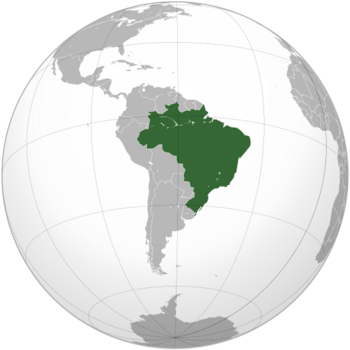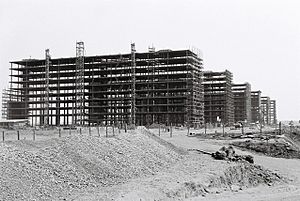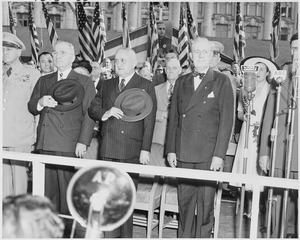Fourth Brazilian Republic facts for kids
Quick facts for kids
Republic of the
United States of Brazil República dos Estados Unidos do Brasil
|
|||||||||
|---|---|---|---|---|---|---|---|---|---|
| 1946–1964 | |||||||||
|
Flag (1960)
|
|||||||||
|
Motto: "Ordem e Progresso"
(English: "Order and Progress") |
|||||||||
|
Anthem: "Hino Nacional Brasileiro"
(English: "Brazilian National Anthem") |
|||||||||
 |
|||||||||
| Capital | Rio de Janeiro (until 1960) Brasília (after 1960) |
||||||||
| Common languages | Portuguese | ||||||||
| Religion
(1950)
|
|
||||||||
| Government | Federal presidential republic (1946–1961; 1963–1964) Federal parliamentary republic (1961–1963) |
||||||||
| President | |||||||||
|
• 1946–1951 (first)
|
Eurico Gaspar Dutra | ||||||||
|
• 1961–1964 (last)
|
João Goulart | ||||||||
| Prime Minister | |||||||||
|
• 1961–1962
|
Tancredo Neves | ||||||||
|
• 1962
|
Brochado da Rocha | ||||||||
|
• 1962–1963
|
Hermes Lima | ||||||||
| Legislature | National Congress | ||||||||
| Senate | |||||||||
| Chamber of Deputies | |||||||||
| Historical era | Cold War | ||||||||
| 31 January 1946 | |||||||||
|
• Democratic Constitution
|
18 September 1946 | ||||||||
|
• Brasília as capital
|
21 April 1960 | ||||||||
|
• Parliamentary system
|
8 September 1961 | ||||||||
|
• Return to presidentialism
|
24 January 1963 | ||||||||
|
• Military coup
|
31 March 1964 | ||||||||
| Population | |||||||||
|
• 1950
|
51,944,397 | ||||||||
|
• 1960
|
70,992,343 | ||||||||
| Currency | Cruzeiro | ||||||||
|
|||||||||
The Fourth Brazilian Republic was a time in Brazil's history from 1946 to 1964. It is also known as the "Populist Republic" or the "Republic of 46." This period saw a lot of political changes and challenges. It ended when the military took control in 1964, starting the Brazilian military dictatorship.
During this time, several presidents led Brazil, including Eurico Gaspar Dutra, Getúlio Vargas, Café Filho, Juscelino Kubitschek, Jânio Quadros, and João Goulart. Even after being removed from power in 1945, former president Getúlio Vargas still had a lot of influence. Three main political parties were important:
- The Brazilian Labour Party (PTB) and the Social Democratic Party (PSD) supported Vargas.
- The National Democratic Union (UDN) was against him.
Contents
End of the Estado Novo (1945)
After World War II, Brazil's president, Getúlio Vargas, started to make his government more open. His rule, called the Estado Novo, had been influenced by fascist ideas. Vargas allowed political prisoners to be freed, including the leader of the Brazilian Communist Party, Luís Carlos Prestes.
He also introduced new election rules and let political parties campaign. Three main parties became important:
- The National Democratic Union (UDN) was formed by liberal and right-wing groups who opposed Vargas.
- The Brazilian Social Democratic Party (PSD) was made up of officials and supporters of the Estado Novo.
- Vargas himself created the Brazilian Labour Party (PTB) for workers and labor unions.
- The Brazilian Communist Party was also made legal again.
The Estado Novo ended on October 29, 1945. Two military leaders, Pedro Aurélio de Góis Monteiro and Eurico Gaspar Dutra, led a peaceful military takeover. The president of the Supreme Federal Court, José Linhares, became the temporary president. He promised fair elections, and Vargas had to retire. Soon after, General Eurico Gaspar Dutra was elected president.
President Dutra (1946–1951)
On September 18, 1946, Brazil adopted its fifth constitution. This marked Brazil's return to a democratic government. During Dutra's time, new organizations were created to help with social services and the military.
In 1946, Dutra closed casinos and banned gambling across the country. He also strengthened ties with the United States. In 1947, he ended relations with the Soviet Union and made the Brazilian Communist Party illegal. His government also started the Superior School of War (ESG) with American help.
Dutra's government had a plan called the "Salte Plan." It focused on improving health, food, transportation, and energy. The plan aimed to manage public spending better and invest in key areas. Brazil's economy grew by an average of 7.6% each year during his presidency.
In 1950, Brazil hosted the 1950 FIFA World Cup. The famous Maracanã Stadium was built for this event. Also, construction began on the Paulo Afonso power plant and the Presidente Dutra highway, which connects Rio de Janeiro to São Paulo.
President Vargas Returns (1951–1954)
In 1950, Getúlio Vargas was elected president again, returning to power. His new term faced many challenges, including economic problems and opposition from Congress. Vargas announced a big plan to industrialize Brazil and take control of the country's natural resources. He created Petrobras, which is Brazil's state-owned oil company, to reduce reliance on foreign companies.
By 1954, Vargas faced strong opposition from the UDN party and the military. A major event, known as the "Rua Tonelero" crime, involved the murder of a military officer by some of the president's bodyguards. This led to a huge public outcry against Vargas. Army generals demanded that he resign.
Vargas refused to leave the presidential palace alive. He believed that if he resigned, another military takeover would happen, possibly with worse results. On August 24, 1954, he shot himself, leaving a letter blaming "international groups" and "revolted national groups." His death caused a huge reaction across Brazil. It also delayed a full military dictatorship for about 10 years.
What Happened to Brazilian Populism?
Getúlio Vargas's style of leadership, called populism, changed over time. It helped to reduce the power of large landowners and paved the way for more democratic times in the 1950s and 1960s. However, this period ended with a military takeover in 1964.
After Vargas's death in 1954, the support for Brazilian populism started to weaken. His removal from power in 1945 and his tragic death showed that this political style was already struggling. Populism continued for another decade but in new ways. In the 1930s and 1940s, it was more about controlling different groups in society. By the 1950s and early 1960s, it focused more on nationalism and developing the country. These changes led to the crisis that resulted in the military government after 1964.
Under President João Goulart (1961–1964), who was a supporter of Vargas, the government became very close to workers, farmers, and even the Communist Party. However, the powerful groups in Brazil, including the military and wealthy business owners, did not like this left-leaning direction. This led to the 1964 military takeover.
Interim Presidents (1954–1956)
After Vargas's death, Vice President Café Filho became president on August 24, 1954. He served until November 8, 1955, when he became ill. The President of the Chamber of Deputies, Carlos Luz, took over briefly. However, he was quickly removed by Congress under pressure from the army.
Then, the Vice President of the Federal Senate, Nereu Ramos, became interim president. He served until January 31, 1956, when the newly elected president, Juscelino Kubitschek, took office.
President Kubitschek (1956–1961)

Kubitschek's time as president was a period of hope and progress. He promised "fifty years of progress in five." He introduced a national development plan with 31 goals, focusing on:
- Energy
- Transportation
- Food
- Basic industries
- Education
- The main goal: building a new capital city, Brasília.
This plan aimed to make Brazil's economy more diverse and grow its industries. Kubitschek encouraged the growth of the automobile, naval, and heavy industries, and built hydroelectric power plants. He mostly focused on private companies, not state-owned ones.
Kubitschek sought foreign investment to achieve this progress. Foreign companies received benefits like tax breaks and help with importing machinery. However, this influx of foreign money sometimes made it hard for local industries to compete.
In 1958, Brazil won the 1958 FIFA World Cup, which was a big moment for the country.
By the end of his term, Brazil's foreign debt had grown significantly. There was also more inflation and a bigger gap between rich and poor. Strikes by workers in both rural and urban areas became more common.
President Quadros (1961)
Jânio Quadros was elected president of Brazil by a large margin in 1960. He was the candidate for the National Labor Party (PTN). When Quadros took office on January 31, 1961, it was a historic moment. It was the first time since Brazil became a republic in 1889 that power was peacefully transferred from one government to an elected opposition leader.
Quadros blamed the previous president, Juscelino Kubitschek, for the high inflation. As president, Quadros made some unusual decisions. He outlawed gambling and banned women from wearing bikinis on the beach. He also tried to make Brazil more neutral in international politics by establishing relations with the Soviet Union and Cuba during the Cold War. This decision cost him the support of the UDN party in Congress, leaving him with little real power.
The Resignation Crisis
On August 25, 1961, Quadros resigned, saying there were "terrible forces" against him. Many people believe he resigned hoping that the Brazilian people or Congress would beg him to return, giving him more power. However, his plan did not work. Congress accepted his resignation. The president of the Chamber of Deputies, Pascoal Ranieri Mazzilli, took over temporarily. They waited for the vice president, João Goulart, to return from a trip to Communist China.
President Goulart (1961–1964)
João Goulart faced strong opposition from conservative politicians and military officers who did not want him to become president. This led to the "Legality Campaign" where people protested to support Goulart. The crisis was solved by a "parliamentary solution." This meant Goulart's powers as president were reduced, and a new position of Prime Minister was created. Tancredo Neves became the first Prime Minister, and Brazil became a parliamentary republic. Goulart finally took office on September 7, 1961.
Brazil returned to a presidential government in 1963 after a public vote. As Goulart's powers grew, he wanted to make big changes, like land reform and nationalizing businesses. However, he had little support in Congress. His attempts to get support from both sides of the political spectrum ended up alienating everyone.
On April 1, 1964, after a night of planning, rebel troops marched towards Rio de Janeiro. Generals in São Paulo and Rio de Janeiro joined the coup. To prevent a civil war, and knowing the U.S. would support the army, Goulart fled to Uruguay.
|






